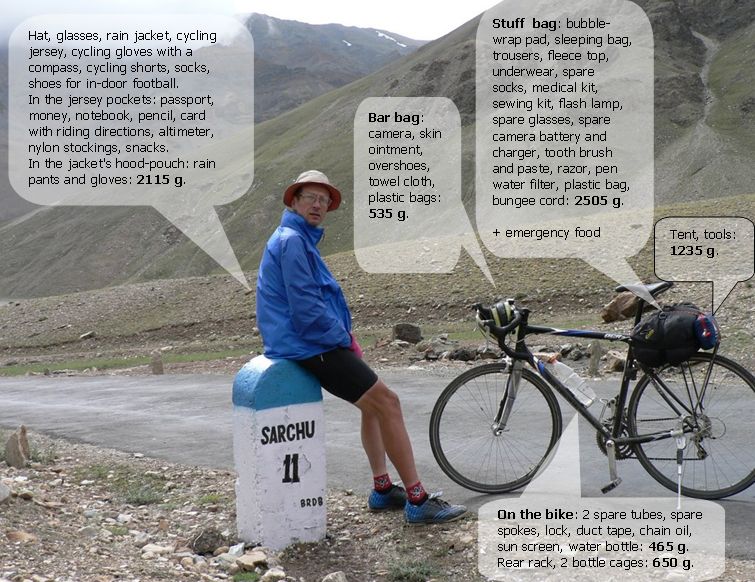
 |




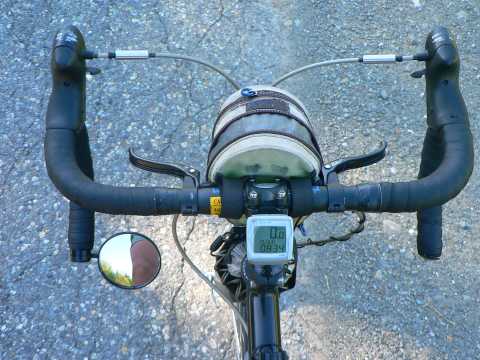 |

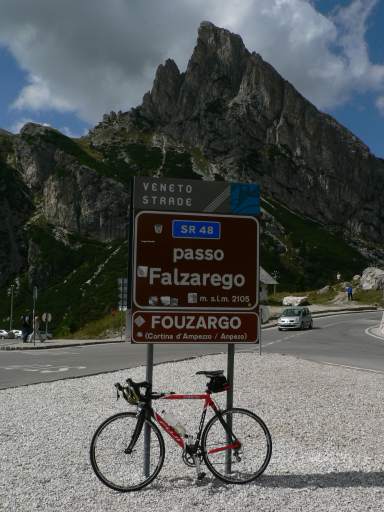
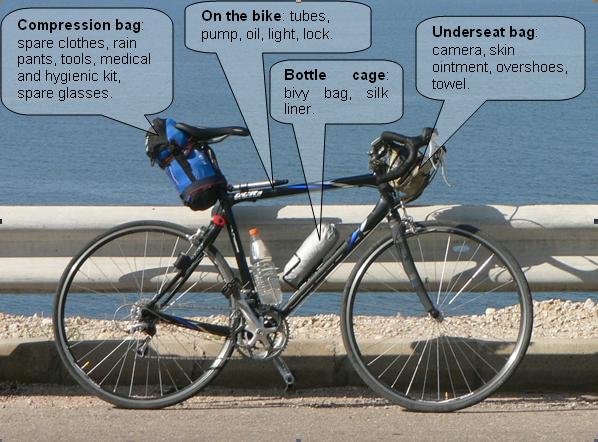

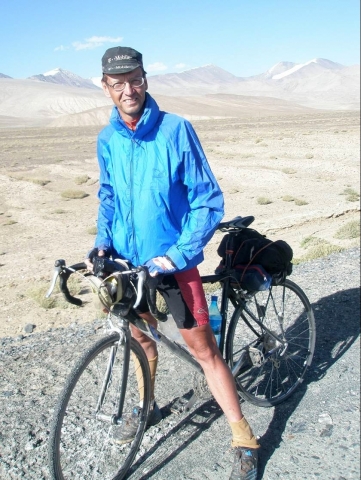
I T E M W E I G H T [grams]
Kyrgyzstan Tibet S.America India Alps Middle Canada
East
FRONT
Handlebar bag. 510 450 510 - - - -
2 small bungee cords. - - 30 - - - -
Underseat bag used as handlebar bag. - - - 90 90 90 90
SLR film camera with battery. 885 885 950 - - - -
Digital camera with battery. - - - 325 325 325 325
'Monocular' - the right part of small 80 - - - - - 80
binoculars with dioptry adjusting ring
used for focusing.
Potocopies of maps, town maps, 10 10 10 5 2 2 2
and distance table (2 A4 sheets).
Parts of maps. 30 10 - - - 2 -
Gloves. 100 110 50 190 64 56 56
Woolen cap. 55 55 - - - 34 -
Neckerchief. 20 15 - 15 - - -
Rain pants. 140 140 140 140 - 135 135
Overshoes. - - 70 70 10 78 78
Tooth brush + paste. 20 20 20 10 6 6 12
Soap. 25 25 25 - - - -
Skin cream. 20 20 20 20 6 10 10
Sun screen. 20 20 - 10 - - -
Razor. 10 10 10 5 2 6 6
Dish washing cloth used as a towel. 10 10 10 10 - 10 10
Lighter. 15 15 15 15 - - -
Pen water filter. 30 20 - 20 - - 20
Plastic bags. 20 20 20 10 10 6 6
2000 1835 1880 935 515 760 830
REAR
Backpack. 830 - - - - - -
Waterproof bag. - 445 - - - - -
Stuff sack. - - 160 160 28 78 160
Tent. 1350 1350 1880 905 - - 888
Bivy bag. - - - - - 262 -
Sleeping bag + plastic bag. 840 1190 1090 1090 - - 592
Silk sleeping sheet. 210 - - - - 174 -
Bungee cords (1 or 2). 160 80 80 100 70 - 70
Nylon straps. - 20 20 20 4 30 -
Foam sleeping pad. 155 155 - - - - -
Strip of bubble wrap. - - 120 120 - - 72
Underwear (1 or 2). 60 30 30 30 30 30 30
Socks (1 or 2). 80 100 30 40 - 40 76
Polar fleece jacket. - 400 - 245 - 250 -
Light fleece jacket. 185 - 185 - 202 - 185
Cotton pullover. 330 - - - - - -
T-shirt. 120 - - - - - -
Long trousers. 320 300 300 300 312 295 295
Tyvec protective suit. - - - - - - 172
Nylon stockings as leg/arm warmers. - 15 15 15 10 - 10
Spare glasses in soft case. 50 50 35 35 35 40 40
Medical kit. Sewing kit. 120 120 85 70 8 20 26
Spare camera battery & charger. 30 - - 170 - - 86
Spare camera films (6 to 8 rolls). 175 160 125 - - - -
Spare cycling computer. - - - 60 - - -
Spare tubes (2 or 1) 200 200 200 200 94 100 100
Mini flash light. 25 25 25 25 42 18 18
Fishing line. - - 30 - - - -
Mosquito net. - - - - - - 14
Cell phone. - - - - - - 70
Plastic bags. 90 90 90 50 30 6 40
5330 4730 4500 3635 865 1343 2944
MIDDLE
Underseat bag. 110 150 - - - - -
Spare tyre 200 250 - - - - -
Cable lock. 170 170 170 170 46 48 48
Spare spokes + nipples. 40 40 20 20 - - -
Duct tape. 30 30 30 30 - 16 18
Tools: Mini tool kit, screwdriver, 390 370 345 400 170 206 236
knife, Tranz-X, pump, patch kit,
pedal+small wrench or adjustable wrench,
spoke tool, tyre levers, hypercracker,
bolts, oil.
940 1010 565 620 216 270 302
MYSELF
Hat/cap/helmet. 90 90 90 90 40 28 30
Glasses. 40 40 40 40 40 40 40
Cycling jersey. 175 175 175 160 170 - 230
Long sleeved jersey. - 275 - - - 204 -
Cycling gloves - - - 45 34 34 28
Arm warmers. - - - - - - 62
Rain/wind jacket. 220 225 500 500 112 112 114
Windstopper. - - - - - 160 160
Cycling shorts. 185 185 185 135 152 152 152
Passport, air tickets. 110 110 90 100 10 48 60
Notebook, calendar and a pencil. 60 50 50 50 12 20 28
Socks. 30 30 30 30 46 20 20
Ankle/knee straps. 10 10 - - 4 4 4
Shoes. - 925 - 660 734 688 616
Sandals. 635 - 635 - - - -
1555 2115 1785 1810 1354 1510 1544
FOOD & WATER
Water in one or two plastic bottles. 2590 2590 2590 1545 925 1045 1045
Food. 200 700 500 300 100 - -
2790 3290 3100 1845 1025 1045 1045
BICYCLE
Bike, rear rack, two bottle cages, 12000 12800 10400 - - - -
kick-stand, computer, altimeter.
Bicycle alone. - - - 9600 1090 9600 9600
1/2 bottle cages with bolts. - - - 140 120 135 72
Rear rack with bolts. - - - 520 - - 454
Computer. - - - 25 25 30 36
Altimeter. - - - 30 - 30 -
Kick-stand. - - - 220 - - -
Mirror. - - - - - - 35
12000 12800 10400 10535 11045 9795 10197
---------------------------------------------------------------------------------------------
TOTAL: GEAR 9825 9690 8740 6970 2950 3883 5792
TOTAL: GEAR+WATER+FOOD 12615 12980 11830 8815 3945 4928 6837
TOTAL: GEAR+BIKE 21825 22490 19140 17505 13995 13678 15989
ALL: GEAR+WATER+FOOD+BIKE 24615 25780 22230 19350 15020 14723 17034
|
ITEM WEIGHT POSITION Frequency
[grams] of use [1-5]
BICYCLE
Bicycle alone. 9600 bike -
2 bottle cages with bolts. 140 bike -
Rear rack with bolts. 520 bike -
Computer with holder, magnet and reciever. 35 bike -
Altimeter. 30 jersey pocket 4
Kick-stand. 220 bike -
Lock. 160 bike 2
10705
CARRIERS
Underseat bag used as handlebar bag. 90 bike -
Main stuff sack (30 L). 160 rear rack -
Stuff sack for tools. 20 tent -
Stuff sack for medical kit, spare glasses, etc. 20 stuff sack -
Bungee cord for the main stuff sack. 70 rear rack -
Spare nylon belt. 20 stuff sack 3
Spare velcro straps. 10 stuff sack 1
Plastic bags. 100 stuff sack 2
490
TOOLS & SPARES
Flat screwdriver 30 tool sack 2
Mini tool kit with spoke key, allen keys 25 tool sack 2
and philips screwdriver
Knife 25 tool sack 2
Pump 100 tool sack 1
Patch kit 20 tool sack 1
15 mm pedal wrench (cut in half) 40 tool sack 1
8 mm & 10 mm wrench 20 tool sack 1
2 tyre levers 10 tool sack 1
Bolts and nuts 20 tool sack 1
Oil 10 bike 2
Duct tape 10 tool sack 2
3 spare spokes 10 rear rack 1
2 spare tubes 200 stuff sack 1
Spare tyre 300 rear rack 1
820
CAMPING
Tent. 905 rear rack 1
Sleeping bag. 1090 stuff sack 1
Strip of bubble wrap (sleeping pad). 120 stuff sack 1
Mini flash light. 25 stuff sack 1
2140
FOOD AND WATER
Water in 1.5 l plastic bottle. 1545 bike -
Emergency food. 300 stuff sack 2
1845
CLOTHES
Hat. 90 myself 5
Glasses. 40 myself 5
Cycling jersey. 160 myself 5
Cycling shorts. 135 myself 5
Cycling gloves 45 myself 4
Socks. 30 myself 5
Shoes. 660 myself 5
Rain/wind jacket. 500 rear rack 4
Neckerchief. 15 stuff sack 2
Polar fleece jacket. 245 stuff sack 2
Long trousers. 300 stuff sack 1
Rain pants. 140 rain jacket 2
Underwear. 30 stuff sack 1
Plastic kitchen gloves. 50 rain jacket 2
Light fleece gloves. 50 rain jacket 3
Overshoes. 70 handlebar bag 2
Spare socks. 40 stuff sack 1
Nylon stockings as leg/arm warmers. 15 jersey pocket 3
2615
PHOTOGRAPHY
Digital camera with battery. 325 handlebar bag 5
Spare camera battery & charger. 170 stuff sack 1
Bubble-wrap protection 10 handlebar bag 5
505
PAPERWORK
Passport, air tickets. 110 myself -
Notebook, calendar and a pencil. 50 jersey pocket 5
Potocopies of town maps and distance table. 10 jersey pocket 5
170
MISCELANEOUS
Tooth brush + paste. 10 stuff sack 1
Skin cream. 20 handlebar bag 4
Sun screen. 10 handlebar bag 2
Razor. 5 stuff sack 1
Dish washing cloth used as a towel. 10 handlebar bag 2
Lighter. 15 stuff sack 1
Pen water filter. 20 stuff sack 2
Spare glasses in soft case. 35 stuff sack 1
Medical kit & sewing kit. 70 stuff sack 2
195
--------------------------------------------------------------------------------------
TOTAL 19485
TOTAL without bicycle, water and food 7035
|


|
2002  | This was the setup in the summer of 2002 in Mongolia and China. Steel road bike with big 630 wheels, front and rear racks, two front panniers, two bottle cages with 0,75 l cycling bottles, 2 kg tent bungeed atop the front rack, 40 l backpack and 5 mm foam sleeping pad on the rear rack and big handlebar bag (which is not on the photo). I wasn't weighing my stuff yet at that time, but the setup was already light in comparison with most of the cyclists. |
2002/3 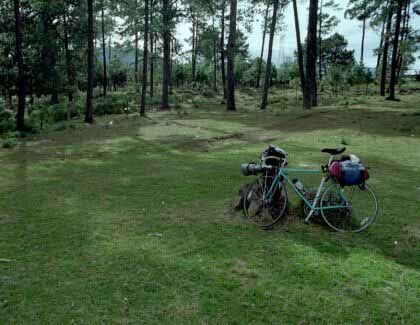 | In the winter 2002/3 I rode in Mexico. I had lighter road bike, this time with the usual 622 wheels. I got rid of the front panniers, but still kept the front rack to bungee the (same) tent on it. The setup at the rear is unchanged. The handlebar bag is still the same. |
2003/4 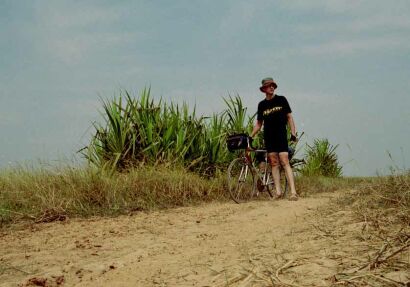 | In the winter 2003/4 I rode from Phnom Penh to Kuala Lumpur. I bought a new lighter steel road bike for this occasion. I wasn't camping on this tour, so I had no tent and sleeping bag. I removed the front rack. The setup at the rear and the handlebar bag are unchanged. I still wasn't weighing my stuff. |
2004  | Summer 2004: 1 month in Kyrgyzstan & China. The bike is the same as the trip before. The setup is also the same with the exception that I had a tent and sleeping bag (in the backpack on the rear rack). I also included an underseat bag (yellow one) for carrying tools. This trip marks the beginning of light weight awareness (and maybe folly?). I started weighing everything, trying to find better (=lighter) solutions. At the end I managed to get the weight of all my stuff down to 9.8 kg, or 21.8 kg including the bike. At that time cycling community considered this as extremely light. |
| I cut the waist belt of the backpack and removed several straps, leaving only shoulder straps so that I can use the backpack for hiking. It lightend the backpack for about 300 g. | The plastic cycling water bottles (0,5 and 0,7 l) were replaced by ordinary 1 litre PVC bottles. You save 40 grams per bottle. | I bought new 1-person single walled tent weighing 1365 grams. That was 500 grams less then the old tent. | I stopped taking tourist guides on tours. At least 300 g saved. | I cut the map and took only the part where I planned on cycling. Big saving in volume and about 50 grams in weight. | I bought smaller and lighter SLR film camera with 28-300 mm lens. 80 grams less, or 600 grams less if I count also the old telephoto lens, which I normally took. | I started using dish washing cloth instead of towel. About 50 g saved - and huge amount of space. | I bought very light foam sleeping pad. It was as big as old one, but weighed 155 g which was 150 g less than the old one. | I bought a small, 25 g flashlight. That's about 80 grams less than the old one. | I used sandals instead of shoes - about 150 g saved. | I had a pen water filter - the first time (30 g with the container). | 2005 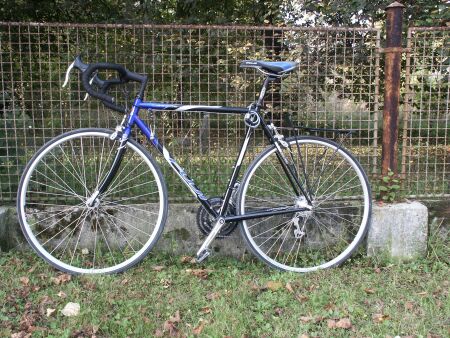 | Tour in China (Xinjiang, Tibet) in summer 2005. I made several changes. This was very demanding tour because of altitute, low temperatures and rough terrain, but I still managed to cut down the stuff by 130 g (to 9.7 kg) - mostly because I used a waterproof bag instead of the backpack. Overall weight including the bike was bigger: 22.5 kg, because of heavier bike. | Replacement of the backpack with a waterproof bag. The bag was 445 grams, which was almost 400 grams less than the backpack. | New down sleeping bag. At 1190 g it was heavier then the old one by 210 g, but was rated at -5 C (old one at +5 C). It packed a little smaller. | No silk sleeping liner: 210 g less. It was not necessary with the warmer sleeping bag. | I used only one bungee cord instead of two: 80 g less. | Only one underwear - 30 g less. | Smaller mulitool: 50 grams less. | I had no maps - not even cut-outs, just a paper with riding directions. | I gave up on "monocular" - a part of small binoculars for birdwatching. 80 g less. | I left the container for pen water filter: 10 g less (+volume). | I had about 50 grams more of warm clothes and 300 g heavier shoes. | I lost the bike and practically all the stuff in Tibet, so I could start building up my gear from the scratch. | 2005/6  | There were some radical changes for a winter tour 2005/2006 in South America. The overall stuff weight was cut down by 950 grams, counting the bike even by 3350 g from the previous trip to China and 2685 grams less from the lightest setup so far (in 2004). Stuff weight 8.7 kg, with the bike 19.1 kg. | I bought new, 2 kg lighter bike. | Stuff bag (160 g) instead of waterproof bag (445 g) - saved 285 g. | Bubble wrap as sleeping pad and waterproofing material for the stuff bag. Not much saved in weight (30 g), but an enormous change in volume and the whole lightweight philosophy. | Lighter gloves: I had only plastic kitchen gloves. 60 g less. This was not a good idea - I suffered from ulnar nerve inflamation. | No woolen cap and neckechief. | No pen water filter. | Only one pair of spare socks, 30 g less. | Much lighter top clothes than in China - it was summer in S. America. Around 220 g less. | I also had some stuff which was heavier: camera (80 g), overshoes (70 g, new addition), tent (530 g more! - I used the old tent from before 2004). | 2006 
| The trip to Indian Himalaya was the peak in the evolution and it set a standard for my ultralight setup. I dropped the weight of the stuff by 1770 g, down to 6970 g (or 17.5 kg with the bike). | Compact (ultrazoom) digital camera instead of SLR film camera. The camera itself with charger and spare battery meant 390 g less. | No spare film rolls: 125 g less for 6 rolls. | Underseat bag used as a handlebar bag: 420 grams less. Since I had small camera and no spare films, I didn't need the big handlebar bag. | Lighter, single skin tent, only 950 grams. Saving of about 900 g from the previous tent and 450 g from the lightest tent I ever had. | I trimmed down the tent for additional 45 grams (removed inner pocket and straps from its bag). | No soap. I relied on the soap in hotels. | I cut the handle of the plastic disponsible razor. Not a big weight, but quite some space saving. Besides, you really need only a small handle for a razor - unlike the tooth brush. | I cut down the medical/sewing kit by 30 g. | Also the amount of plastic wrapping bags was smaller for 40 g. | I bought new light shoes: shoes for in-door football (soccer). At 660 g they were just 25 g heavier than sandals, but infinitely more comfortable and warm, both for cycling as well as walking. | I had some heavier/bulkier stuff: warm gloves (+140 g), fleece top (+70 g), tool kit (+55 - chain tool), cycling gloves (+45 g). | With all these savings I could indulge in a bit of luxury: I mounted a kick-stand (200 g) for the bike. | 2007 
| The trip to Australia was done with similar setup. I dropped the weight of stuff down to around 6200 g, mostly because I expected much warmer weather then in Indian Himalaya. | I used very ligh rain jacket (140 g) instead of my standard 500 g jacket. | Fleece top replaced with lighter one, saving 90 g. | I removed kick-stand. It does provide some luxury by not having to lay down and lift up the bike, however it doesn't provide a stable support (a few times the bike toppled down), so I will not use it again. 200 g less. | I cut the pedal spanner in two - 50 g saved. You don't need a big handle for the pedal spanner: just find a stone and hit the short handle a few times to unscrew the pedals. | I cut 8 cm of seat post, saved about 50 g. | Ligther lock: I bought a tiny combination lock which weighs only 48 grams. 130 g saved. The philosophy is that any lock could be broken by a dedicated thief, so take the lock that just ensures your bike can't be ridden away by occasional passer-by. | No camera battery charger. I estimated that one spare battery will be enough for 1 month trip - and I was right. | Only one spare tube. I relied on availability of those in Australia. | No tooth paste. I brushed the teeth just with water. | Instead of a knife I used razor blades. Quite a volume saving and about 40 g less. | Less pages in a notebook - minus 10 g. | Shorter and lighter wicking cycling socks: 30 g less. | I did use a helmet this time (280 g more). | 2008 
| The trip to Central Asia (Tadjikistan, Kyrgyzistan, China, Pakistan, India) was done with practically the same setup as from 2006. There were little changes, resulting in about 300-400 g less: stuff 6.7 kg, with the bike 17.1 kg. | I bought new down sleeping bag - smaller and almost 100 g lighter, with the same rating (-1 C comfort) as the old one. | I cut off the inner mesh lining form my rain jacket. The weight dropped from 500 g to 370 g. I am still undecided whether this was a good idea or not. | New strip of bubble wrap. The new one was 60 g lighter. I don't know if this comes from different construction or from the dust that collected on the old one. | A hat replaced with a cycling cap: 30 g instead of 90 g. The cap is also an excellent tool for killing flies and mosquitos (a hat would be too heavy for that). | Lighter rain pants - 30 g less, but worse quality. I will go back to heavier ones. | Heavier stuff: there was a spare tyre (300 g) this time. | 2009 
| In the January 2009 I was in the Middle East. This was a rather radical experiment regarding the ultraligh cycle touring. I tested how it would be to tour with just the bivy bag, carrying all the stuff on the bike, without the racks or backpacks. With 3.9 kg of stuff and 13.7 kg including the bike, it meant about 3.7 kg less from my usual "fully loaded" setup as in 2008. | Tent, the sleeping bag and bubble wrap were replaced with a bivy bag and a silk liner. I saved 1.5 kg there. The bivy was carried in the bottle cage holder. | I kept most of my stuff in the compression bag behind the seat. I saved 100 g because of lighter bag and another 40 g by using nylon straps instead of bungee cords. | There was no need for a rear rack. 570 g saved. | The rain jacket was replaced with two items: a windstopper and a light rain shell, both of them together were almost 100 g lighter then the old jacket. | There were a lot of small things that I left out: water filter, sun screen, neckerchief, lighter, battery charger, one spare tube, spare spokes, chain tool, hypercracker, one water bottle. All of this meant about 500 g less. |
2009 
| In the summer of 2009 I rode from Vancouver to New York City. It was a full-kit camping tour with the least weight so far; I managed to cut down my touring weight by almost a kilo. I had 5.8 kg of stuff and 16.0 kg including the bike. | Smaller and lighter rear rack. It's 450 g or 120 g less then the old one. Besides that it attaches to the brake bridge screw and enables me to adjust the brakes without the need to remove the rack. | Lighter road tyres 25x622. Almost 300 g lighter then the 32x622 Schwalbe Marathons. Only one tube - 100 g less. No spare spokes. No spare tyre. | I bought the lightest pump there is: 25 g, means almost 50 g less. It's also a bit smaller. | Only one bottle cage and one water bottle: 110 g saved. | I bought a new summer down sleeping bag. With 600 g for a bag with light compressioin bag it was 350 g lighter than my 3-season sleeping bag. | I had new lighgter shoes, 60 g less. | A few things left out: beanie, battery charger, card reader, altimeter, hypercracker. Smaller first-aid kit. In all about 150 g less. | The clothes were different from the last year's tour, but the overall weigth was practicaly the same. Rain gear and cycling shorts were lighter, but the merino cycling jersey and arm warmers were heavier. | I did have some new additions. Rear view mirror. I took a 170 g tyvec protective suit (meant as rain gear). Cell phone (70 g) and "monocular" for watching birds (80 g) didn't work at all and were never used. I threw monocular away on the 3rd day. | NEW 2010 | I am planning a new tour in august/september of 2010. It would be a mini "Africa's coast-to-coast", through Namibia, Botswana and South Africa. To start with, I am taking stuff from the 2009 trip in Canada and then reducing it for about a kilo: 4.8 kg of stuff and 15.1 kg including the bike. | After having illusions for 20 years about me becoming the National Geographic's featured photographer I finaly realized that it is not going to happen. So I bought a very popular "travelling ultrazoom compact" and I am quite happy with it. It weighs 220 g and saves me 150 g, counting in the charger as well. | I am thinking of using "crocs" as my only footware. They are incredibly light (320 grams a pair), comfortable, have excellent pedal grip, can be used for fording rivers or as bathroom slippers, and they dry in a second. Complemented with some kind of waterproof/windproof socks, they may be the ultimate cycle-touring footware. Saving 340 grams!!! | The things left out: rain shell, rain pants, fleece gloves, overshoes, tyvec suit, "monocular", mosquito net, spare socks. I don't expect much rain this time, so my windbreaker jacket (160 g) will have to suffice. Will mean 660 g less. | Lighter synthetic jersey: 70 g less. Merino jeseys are excellent, they are warmer and quicker drying then synthetics, but heavier. This time I really wanted to cut the weight to minimum, so I decided against the comfort of merino jersey. | Additions: second bottle cage and water bottle, heavier front tyre, beanie: 240 g more. |